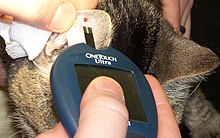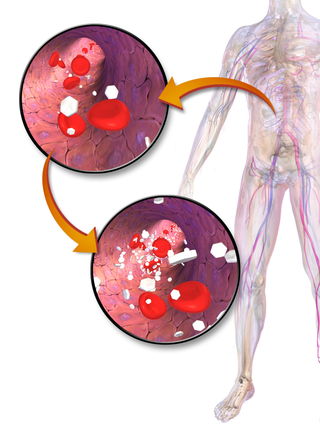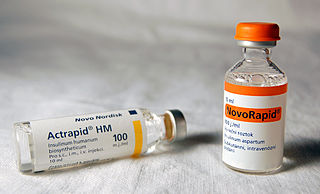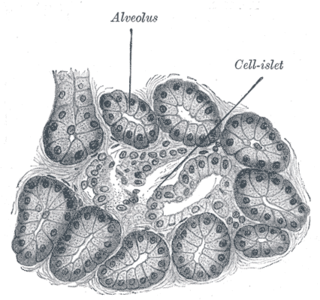Management
Diabetes is a condition which can be treated, but it is invariably lethal if ignored. Early diagnosis and treatment by a qualified veterinarian can help in preventing nerve damage, and, in rare cases, may even lead to remission. [11] Diabetic cats do best with long-lasting twice-daily injections of insulin such as glargine (which as of 2022 is available worldwide as a synthetic generic drug) combined with a low carbohydrate diet. Because diabetes is a disease of carbohydrate metabolism, a move to a primarily protein and fat diet reduces the occurrence and recurrence of hyperglycemia.
Diet
Diet is a critical component of treatment and is in some cases effective on its own following treatment with insulin. For example, a recent mini-study [12] showed that many diabetic cats stopped needing insulin after changing to a low carbohydrate diet. The rationale is that a low-carbohydrate diet reduces the amount of insulin needed and keeps the variation in blood sugar low and easier to predict. Also, fats and proteins are metabolized slower than carbohydrates, reducing dangerous blood sugar peaks right after meals.
Recent recommended diets are trending towards a low-carbohydrate diet for cats [13] [14] rather than the formerly recommended high-fiber diet. Carbohydrate levels are highest in dry cat foods made out of grains (even the expensive "prescription" types), so cats are better off with a canned diet that is protein and fat focused. Both prescription canned foods made for diabetic cats and regular brand foods are effective. Owners should aim to supply no more than 10% of the daily energy requirement of cats with carbohydrates.
Medications
Oral medications like Glipizide that stimulate the pancreas, promoting insulin release (or in some cases, reduce glucose production), are less and less used in cats, [15] and these drugs may be completely ineffective if the pancreas is not working. These drugs have also been shown in some studies [16] to damage the pancreas further or to cause liver damage. Some owners are reluctant to switch from pills to insulin injections, but the fear is unjustified; the difference in cost and convenience is minor (most cats are easier to inject than to pill), and injections are more effective at treating the disease.
Bexagliflozin (Bexacat) was approved for medical use in the United States in December 2022. [17] [18] It is the first sodium-glucose cotransporter 2 (SGLT2) inhibitor new animal drug approved by the US Food and Drug Administration (FDA) in any animal species. [17]
Insulin
The method usually employed is a dose of slow-acting insulin twice daily to keep the blood sugar within a recommended range for the entire day. With this method, it is important for the cat to avoid large meals or high-carbohydrate food. Meals may also be timed to coincide with peak insulin activity. Once-daily doses are not recommended, [19] since insulin usually metabolizes faster in cats than in humans or dogs. [20] For example, an insulin brand that lasts 24 hours in people may only be effective for about 12 in a cat. [21]
Cats may be treated with animal insulin (bovine-based insulin is most similar to cat insulin) or with human synthetic insulin. The best choice of insulin brand and type varies from animal to animal and may require some trial and error. The human synthetic insulin, Humulin N /Novolin N/ NPH, is usually a poor choice for cats, [21] since cats metabolize insulin about twice as fast. The Lente and Ultralente versions were popular for feline use until summer 2005, when they were discontinued.
Until the early 1990s, the most recommended type for pets was bovine/porcine-derived PZI, [22] but that type was phased out over the 1990s and is now difficult to find in many countries. There are sources in the US and UK, and many vets are now starting to recommend them again for pets, but they have been discontinued by most manufacturers as of 2007 [update] -2008. A new synthetic PZI analogue called ProZinc is now available.
Caninsulin (known in the US as Vetsulin) is a brand of porcine-based insulin approved for cats which is available with a veterinarian's prescription. According to the manufacturer's website, the insulin's action profile in cats was similar to that of NPH insulin, and it lowered blood sugar quickly, but for only about 6–8 hours. Vetsulin was recalled in the US in November 2009 due to inconsistent strength; it was available again as of April 2013 [update] . [23]
Two ultra-slow time-release synthetic human insulins became available in 2004 and 2005, generically known as insulin detemir (Levemir) and insulin glargine (Lantus). Studies have had good results with insulin glargine in cats. [24] Follow-up research [25] shows that Levemir can be used with a similar protocol and that either insulin on this protocol can lead uncomplicated feline cases to remission, with the most success being in cats who start on these protocols as soon as possible after diagnosis.
Dosage and regulation
Cats may have their mealtimes strictly scheduled and planned to match with injection times, especially when on insulin with a pronounced peak action like Caninsulin/Vetsulin or Humulin N. If the cat free-feeds and normally eats little bits all day or night, it may be best to use a very slow-acting insulin to keep a constant level of blood glucose. Some veterinarians still use the outdated recommendation of using Humulin "N" or NPH insulin for cats, which is very fast-acting for most cats. [19] The slower-acting Lente and Ultralente (Humulin L and Humulin U) insulins were discontinued in 2005), so most cats are treated with either the veterinary PZI insulins or the new full-day analogs glargine (Lantus) and detemir (Levemir).
The first goal is to regulate the cat's blood glucose by keeping the blood glucose values in a comfortable range for the cat during most of the day. This may take a few weeks to achieve.
The most successful documented method is tight regulation with Lantus or Levemir. [26]
Typical obstacles to regulation include:
- Chronic overdose masked by Somogyi: A dose that is too high may cause a Somogyi rebound, which can look like a need for more insulin. This condition can continue for days or weeks.
- High-carbohydrate cat food: Many commercial foods (especially "light" foods) are very high in carbohydrates. The extra carbohydrates keep the cat's blood sugar high. In general, canned foods are lower in carbohydrates than dry foods, and canned "kitten" foods lower still. Diabetes in cats can be better regulated and even sometimes reversed with a low-carbohydrate diet. [27]
- Inappropriate insulin: Different brands and types of insulin have idiosyncratic effects on different cats. With some dosages, the insulin may not last long enough for the cat. Testing blood sugar more frequently can determine if the insulin is controlling the blood sugar concentration throughout the day.
Blood sugar guidelines

Absolute numbers vary between pets, and with meter calibrations. Glucometers made for humans are generally accurate using feline blood except when reading lower ranges of blood glucose (<80 mg/dl–4.44 mmol/L). At this point the size difference in human and animal red blood cells can create inaccurate readings. [28]
Somogyi rebound
Too much insulin may result in a contradictory increase of blood glucose. This "Somogyi effect" is often noted by cat owners who monitor their cat's blood glucose at home. Any time the blood glucose level drops too far to hypoglycemia, the body may defensively dump glucose (converted from glycogen in the liver), as well as hormones epinephrine and cortisol, into the bloodstream. The glycogen raises the blood glucose, while the other hormones may make the cat insulin-resistant for a time. If the body has no glycogen reserves, there will be no rebound effect and the cat will just be hypoglycemic. [29]
Rebound hyperglycemia occurs rarely in cats treated with glargine in a protocol aiming for tight control of blood glucose concentrations. [30]
Hypoglycemia
An acute hypoglycemic episode (very low blood sugar) can happen to even careful pet owners, since cats' insulin requirements sometimes change without warning. The symptoms include depression/lethargy, confusion/dizziness, loss of excretory/bladder control, vomiting, and then loss of consciousness and/or seizures. Immediate treatment includes administering honey or corn syrup by rubbing on the gums of the cat (even if unconscious, but not if in seizures). Symptomatic hypoglycemia in cats is a medical emergency and the cat will require professional medical attention. The honey/corn syrup should continue to be administered on the way to the vet, as every minute without blood sugar causes brain damage.
A cat with hypoglycemia according to a human-calibrated blood glucose meter (<2.2 mmol/L or 40 mg/dL), but with no symptoms, should be fed as soon as possible. Hypoglycemic cats that refuse to eat can be force-fed honey or corn syrup until they stabilize, though this may not be done if the animal is unconscious or having a seizure, as the liquid is likely to enter the animal's lungs and cause choking and asphyxiation.
Mild hypoglycemic episodes can go unnoticed or leave evidence such as urine pools outside the litter box. In these cases the blood sugar will probably appear paradoxically high upon the next test hours later, since the cat's body will react to the low blood sugar by stimulating the liver to release stored glycogen.






